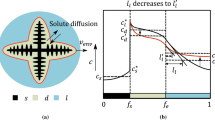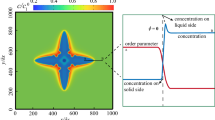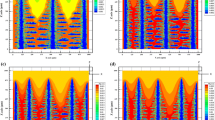Abstract
In this investigation, a model has been developed for determination of liquid flow permeability through dendritic structures during equiaxed dendrite growth. Two separate computational models have been coupled for modeling the permeability and coarsening in mushy alloys. The dendrite growth has been simulated using a cellular automation finite difference analysis, while the fluid flow has been modeled employing computational fluid dynamic. A new approach has also been proposed in calculation of the coarsening phenomenon as well as modification of the micro fluid flow based on switching between permeability and pressure gradients at high solid fractions. The predictions show that in high solid fractions, an iterated algorithm on the permeability gradient at a given pressure is closer to the experimental results. Therefore, under these circumstances, the continuity equation would not be satisfied by prediction and correction of the pressure field. Instead, the continuity equation would be satisfied by iteration and correction of the local permeability at a constant pressure gradient.
















Similar content being viewed by others
References
H. Darcy: Les Fontaines Publiques De Ville de Dijon, Victor Dalmont, Paris, 1856, p. 647
M.V. Bruschke, S.G. Advani: J. Rheol., 1993, vol. 37, pp. 479–98
B.R. Gebart: J. Compos. Mater., 1992, vol. 26, pp. 1100–33
J.F. McCartney: Phys. Fluids, 1994, vol. 6, pp. 435–47
L. Donald, C. Koch: J. Fluid Mech., 1997, vol. 349, pp. 31–66
D.A. Edwards, M. Shapiro: Phys. Fluid, 1990, vol. 2, pp. 45–55
D. Bernard, O. Nielsen, L. Salvo et al.: Phys. Fluids, 1995, vol. 7, pp. 2563–75
D. Nagelhout, M.S. Bhat: Mater. Sci. Eng., 1995, vol. 191, pp. 203–08
A. Eidsath: Chem. Eng. Sci., 1983, vol. 38, pp. 1803–16
S. Ganesan, C.L. Chan, D.R. Poirier: Mater. Sci. Eng. A, 1992, vol. 151, pp. 97–105
J.F. McCarthy: Acta Metall. Mater., 1994, vol. 42, pp. 1573–81
M.S. Bhat, D.R. Poirier, J.C. Heinrich: Metall. Mater. Trans. B, 1995, vol. 26B, pp. 1049–56
B. Goyeau, T. Benihaddadene, D. Gobin, and M. Quintard: in Modeling of Casting, Welding and Advanced Solidification Processes, B.G. Thomas and C. Beckermann, eds., TMS, Warrendale, PA, 1998, vol. VIII, pp. 353–60
B. Bjerkholt: Master’s Thesis, University of Oslo, Oslo, 1999
H.-J. Diepers, C. Beckermann, I. Steinbach: Acta Mater., 1999, vol. 47, pp. 3663–78
S.G.R. Brown, J.A. Spittle, D.J. Jarvis, R. Walden-Bevan: Acta Mater., 2002, vol. 50, pp. 1559–69
D.J. Jarvis, S.G.R. Brown, J.A. Spittle: Mater. Sci. Technol., 2000, vol. 16, pp. 1420–24
S. Whitaker: Transport Porous Media, 1996, vol. 25, pp. 27–61
H.J. Diepers, C. Beckermann, I. Steinbach: Acta Mater., 1999, vol. 47, pp. 3663–78
Goyeau, T. Benihaddandene, D. Gobin, and M. Quintard: Metall. Mater. Trans. B, 1999, vol. 30B, pp. 613–22
R.G. Santos, M.L.N.M. Melo: Mater. Sci. Eng. A, 2005, vol. 391, pp.151–58
T.S. Piwonka, M.C. Flemings: Trans. TMS-AIME, 1966, vol. 236, 1157–65.
D. Apelian, M.C. Flemings, R. Mehrabian: Metall. Trans. B, 1974, vol. 5B, pp. 2533–37
N. Streat, F. Weinberg: Metall. Trans. B, 1976, vol. 7B, pp. 417–23
R. Nasser-Rafi, R. Desamukh, D.R. Poirier: Metall. Trans. A, 1985, vol. 16A, pp. 2263–71
K. Murakami, T. Shiraishi, T. Okamoto: Acta Metall., 1983, vol. 31, pp. 1417–24
K. Murakami, T. Shiraishi, T. Okamoto: Acta Metall., 1984, vol. 32, pp. 1423–28
K. Murakami, T. Shiraishi, T. Okamoto: Acta Metall., 1984, vol. 32, pp. 1741–44
D.R. Poirier, S. Ganesan: Mater. Sci. Eng. A, 1992, vol. 157, pp. 113–23
D.R. Poirier, P. Ocansey: Mater. Sci. Eng. A, 1993, vol. 171, pp. 231–40
A.J. Duncan, Q. Han, S. Viswanathan: Metall. Mater. Trans. B, 1999, vol. 30B, pp. 745–50
O. Nielsen, L. Arnberg, A. Mo, H.S. Thevik: Metall. Mater. Trans. A, 1999, vol. 30A, pp. 2455–62
O. Nielsen, L. Arnberg: Metall. Mater. Trans. A, 2000, vol. 31A, pp. 3149–53
R.C. Atwood, S. Sridhar, W. Zhang, P.D. Lee: Acta Mater., 2000, vol. 48, pp. 405–17
P.D. Lee, A. Chirazi, D. See: J. Light Met., 2001, vol. 1, pp. 15–30
W. Kurz, B. Giovanola, R. Trivedi: Acta Metall., 1986, vol. 34, pp. 823–30
W. Kurz, C. Bezencon: Sci. Technol. Adv. Mater., 2001, vol. 12, pp. 185–91
S.K. Kailasam, M.E. Glicksman: Acta Mater., 1986, vol. 34, pp. 823–36
S.M.H. Mirbagheri: Commun. Numer. Meth. Eng., 2007, vol. 23, pp. 295–312
H.B. Dong and P.D. Lee: Acta Mater., 2005, vol. 53, pp. 659–68, 661
S.M.H. Mirbagheri, N. Varahram, P. Davami: Int. J. Num. Meth. Eng., 2003, vol. 58, pp. 723–48
C.W. Hirt, B.D. Nichols: J. Comput. Phys., 1981, vol. 39, pp. 201–25
T. Campanella, C. Charbon, M. Rappaz: Scripta Mater., 2003, vol. 49, pp. 1029–34
T. Jalanti: Ph.D. Thesis, Ecole Polytechnique Federale de Lausanne, 2000
S. Ganesan, D.R. Poirier: Metall. Mater. Trans. B, 1990, vol. 21B, pp. 173–81
J.C. Heinrich, D.R. Poirier: Model. Simul. Mater. Sci. Eng., 2004, vol. 12, pp. 881–99
S.M.H. Mirbagheri, J. Silk: Mater. Des., 2006, vol. 27, pp. 115–24
P. Zhao, J.C. Heinrich, and D.R. Poirier: Proc. AIAA 42nd Aerospace Science Meeting, AIAA2004, Reno, Nevada, 2004, p. 411
D.R. Poirier, P. Ocansey: Mater. Sci. Eng. A, 1993, vol. 171, pp. 231–40.
D.R. Poirier, P.J. Nandapurkar, S. Ganesan: Metall. Trans. B, 1991, vol. 22B, pp. 889–900.
M.D. Peres, C.A. Siqueira, A. Garcia: J. Alloys Compd., 2004, vol. 381, pp. 168–81.
M.L.M.N. Melo, E.M.S. Rizzo, R.G. Santos: Mater. Sci. Eng. A, 2004, vol. 374, pp. 351–61
Smithells Metals Reference Book, 7th ed., E.A. Brandes and G.B. Brook, eds., Butterworth-Heineman, Oxford, United Kingdom, 1992, chapter 11, p. 421
H.R. Thresh, A.F. Crawley: Metall. Trans., 1970, vol. 1, pp. 1531–35
J.R. Sarazin, A. Hellawell: Metall. Trans. A, 1988, vol. 19A, pp. 1861–71
J. Guo, C. Beckermann: Num. Heat Transfer Part A, 2003, vol. 44, pp. 559–76
S.D. Elliot: Ph.D. Thesis, University of Queensland, Queensland, Australia, 1999
Acknowledgments
The author expresses his warm thanks to Professor S. Serajzadeh and Mr. E. Khajeh for their valuable comments. He also acknowledges with gratitude the Department of Materials, Imperial College, London, for the research support.
Author information
Authors and Affiliations
Corresponding author
Additional information
Manuscript submitted May 31, 2007.
An erratum to this article can be found at http://dx.doi.org/10.1007/s11663-009-9325-0
Appendix A
Appendix A
Finite difference approximations
-
(1)
The finite difference approximations of momentum transport equation are follows:[41,57]
$$ U^{{n + 1}}_{{i,j,k}} = U^{n}_{{i,j,k}} + \Delta t{\left[ {\frac{{P^{{n + 1}}_{{i,j,k}} - P^{{n + 1}}_{{i + 1,j,k}} }} {{\rho \Delta x}} + g_{x} - FUX - FUY - FUZ + VISX + PERX} \right]} $$(A1)$$ V^{{n + 1}}_{{i,j,k}} = V^{n}_{{i,j,k}} + \Delta t{\left[ {\frac{{P^{{n + 1}}_{{i,j,k}} - P^{{n + 1}}_{{i,j + 1,k}} }} {{\rho \Delta y}} + g_{Y} - FVX - FVY - FVZ + VISY + PERY} \right]} $$(A2)$$ W^{{n + 1}}_{{i,j,k}} = W^{n}_{{i,j,k}} + \Delta t{\left[ {\frac{{P^{{n + 1}}_{{i,j,k}} - P^{{n + 1}}_{{i,j,k + 1}} }} {{\rho \Delta z}} + g_{Z} - FWX - FWY - FWZ + VISZ + PERZ} \right]} $$(A3)where
$$ FUX = \frac{{U^{n}_{{i,j,k}} }} {{2\Delta x}}{\left[ {DUL + DUR + \alpha {\text{Sign}}(U_{\alpha } )(DUL - DUR)} \right]} $$$$ DUL = U^{n}_{{i,j,k}} - U^{n}_{{i - 1,j,k}} \quad DUR = U^{n}_{{i + 1,j,k}} - U^{n}_{{i,j,k}} ;\quad U_{\alpha } = (DUR + DUL)/2 $$$$ VISX = \upsilon \;{\left( {\frac{{U^{n}_{{i + 1,j,k}} - 2U^{n}_{{i,j,k}} + U^{n}_{{i - 1,j,k}} }} {{\Delta x^{2} }} + \frac{{U^{n}_{{i,j + 1,k}} - 2U^{n}_{{i,j,k}} + U^{n}_{{i,j - 1,k}} }} {{\Delta y^{2} }} + \frac{{U^{n}_{{i,j,k + 1}} - 2U^{n}_{{i,j,k}} + U_{{i,j,k - 1}} }} {{\Delta z^{2} }}} \right)} $$$$ PERX = \upsilon {\left( {f_{L} } \right)}{\left[ {KX_{{i,j,k}} } \right]}^{{ - 1}} U^{n}_{{i,j,k}} $$where \( {\mathbf{V}} = U\,\hat{i} + V\,\hat{j} + W\,\hat{k} \), KX is the local permeability in the x direction, and the superscripts (n) and (n + l) indicate the old and the new time-steps, respectively. α = 0 or 1 is the control factor for upwind and centered differencing, respectively. A similar method is used for the calculation of the advective flux terms FUY, FUZ, FVX, FVY, FVZ, FWX, FWY, and FWZ, the viscous flux terms VISY and VISZ, and the permeability terms PERY and PERZ.
-
(2)
The finite difference approximation to the continuity equation is
$$ D_{{i,j,k}} = \frac{{U^{{n + 1}}_{{i,j,k}} \;\, - U^{{n + 1}}_{{i - 1,j,k}} }} {{\Delta x}} + \frac{{V^{{n + 1}}_{{i,j,k}} \, - V^{{n + 1}}_{{i,j - 1,k}} }} {{\Delta y}} + \frac{{W^{{n + 1}}_{{i,j,k}} \, - W^{{n + 1}}_{{i,j,k - 1}} \,}} {{\Delta z}} = - M_{{i,j,k}} $$(A4)where
$$ \left\{ \begin{aligned}{} M_{{i,j,k}} = \frac{{\rho _{L} - \rho _{S} }} {{\rho _{{mu}} }}{\left( {DFT + UFX + VFY + WFZ} \right)}\quad \quad if\quad & 0 < f_{{L_{{i,j,k}} }} \le 1 \\ M_{{i,j,k}} = 0.0\quad \quad \quad \quad \quad \quad \quad \quad \quad \quad \quad \quad \quad \quad \quad \quad & {\text{otherwise}} \\ \end{aligned} \right. $$$$ DFT = \frac{{f^{{n + 1}}_{{L_{{i,j,k}} }} - f^{n}_{{L_{{i,j,k}} }} }} {{\Delta t}};\quad UFX = 0.5{\left( {U_{{i,j,k}} + U_{{i - 1,j,k}} } \right)}\frac{{f^{n}_{{L_{{i + 1,j,k}} }} - f^{n}_{{L_{{i - 1,j,k}} }} }} {{2\Delta x}} $$$$ VFY = 0.5{\left( {V_{{i,j,k}} + V_{{i,j - 1,k}} } \right)}\frac{{f^{n}_{{L_{{i,j + 1,k}} }} - f^{n} _{{L_{{i,j - 1,k}} }} }} {{2\Delta y}};\quad WFZ = 0.5{\left( {W_{{i,j,k}} + W_{{i,j,k - 1}} } \right)}\,\frac{{f^{n}_{{L_{{i,j,k + 1}} }} - f^{n}_{{L_{{i,j,k - 1}} }} }} {{2\Delta z}} $$ -
(3)
The finite difference approximation of the heat-transfer equation is
$$ T^{{n + 1}}_{{i,j,k}} = T^{n}_{{i,j,k}} - \Delta t{\left[ {{\left( {UTX + VTY + WTZ} \right)} + {\left( {DQX + DQY + DQZ} \right)}} \right]} $$(A5)$$ UTX = 0.5{\left\{ {(1 + \alpha )U_{{i - 1,j,k}} (DTXL) + (1 - \alpha )U_{{i,j,k}} (DTXR)} \right\}} $$$$ DTXL = \frac{{T_{{i,j,k}} - T_{{i - 1,j,k}} }} {{\Delta x}};\quad DTXR = \frac{{T_{{i + 1,j,k}} - T_{{i,j,k}} }} {{\Delta x}} $$$$ DQX = \frac{{QXR - QXL}} {{\rho \,C_{{\rm P}} \,\Delta x}};\quad QXR = - k_{R} \frac{{T^{n}_{{i + 1,j,k}} - T^{n}_{{i,j,k}} }} {{\Delta x}};\quad QXL = - k_{l} \frac{{T^{n}_{{i,j,k}} - T^{n}_{{i - 1,j,k}} }} {{\Delta x}} $$$$ QXR = - k_{R} \frac{{T^{n}_{{i + 1,j}} - T^{n}_{{i,j}} }} {{\Delta x}},\quad QXL = - k_{l} \frac{{T^{n}_{{i,j}} - T^{n}_{{i - 1,j}} }} {{\Delta x}} $$
The convection terms, VTY and WTZ, and the thermal diffusion fluxes, DQY and DQZ, are found in a similar way. In the mushy zone (freezing range), the liquid fraction and the specific heat are calculated from Eqs. [9] and [14].
In the CFD program, the first guesses for the new-time levels, namely, U n+1 , V n+1, and W n+1, are calculated by an explicit approximation with the old time-level (U n , V n, and W n) values. In the first step of the solution, therefore, the P n+1 values in Eqs. [A1] through [A3] are replaced by P n. Then, the guess velocities are put into continuity Eq. [A4]. In order to satisfy the continuity Eq. [A4], the velocities as well as pressures on the computational cells should be adjusted iteratively with Eq. [A6] for the low solid fraction and Eq. [A7] for the high solid fraction, separately. For 3-D cells of the low solid fraction, 0 ≤ f S ≤ 0.79, in each iteration, values of the δP i,j,k and the velocities on the sides of the 3-D cell are found as follows:
where
For 3-D cells of the high solid fraction (0.79 < f S ≤ 1.0), due to coarsening phenomenon for remaining liquid between solid grains, the velocity field must be corrected by the criteria of the permeability (\( \ifmmode\expandafter\tilde\else\expandafter\sim \fi{K}_{{i,j,k}} \)) not by the criteria of the pressure (δP i,j,k ). During the iterative calculations, \( \ifmmode\expandafter\tilde\else\expandafter\sim \fi{K}_{{i,j,k}} \) can be determined by differentiating Darcy’s equation, i.e., μ∇(V) = ∇(K∇P) = ∇K · ∇P + K ∇ 2 P, under conditions that we can ignore the ∇K ∇P term for very small interdendritic material volumes. Therefore, the velocities may be estimated based on Darcy’s law (\( {\partial {\mathbf{V}}} \mathord{\left/ {\vphantom {{\partial {\mathbf{V}}} {\partial t}}} \right. \kern-\nulldelimiterspace} {\partial t} = - \upsilon f{\mathbf{V}}\;{\left[ { \ifmmode\expandafter\tilde\else\expandafter\sim \fi{K}} \right]}^{{ - 1}} \)) and the \( \ifmmode\expandafter\tilde\else\expandafter\sim \fi{K}_{{i,j,k}} \) as follows:
where ω is over-relaxation, and
The preceding velocities are then put into the continuity equation again, and the outlined procedures are repeated. This new procedure is capable of considering solid grain coarsening during final stages of solidification (i.e., high solid fraction). Convergence of iteration is achieved when D i,j,k < 10−6.
Rights and permissions
About this article
Cite this article
Mirbagheri, S. Modeling of the Equiaxed Dendrite Coarsening Based on the Interdendritic Liquid Permeability during Alloy Solidification. Metall Mater Trans B 39, 469–483 (2008). https://doi.org/10.1007/s11663-008-9149-3
Published:
Issue Date:
DOI: https://doi.org/10.1007/s11663-008-9149-3




